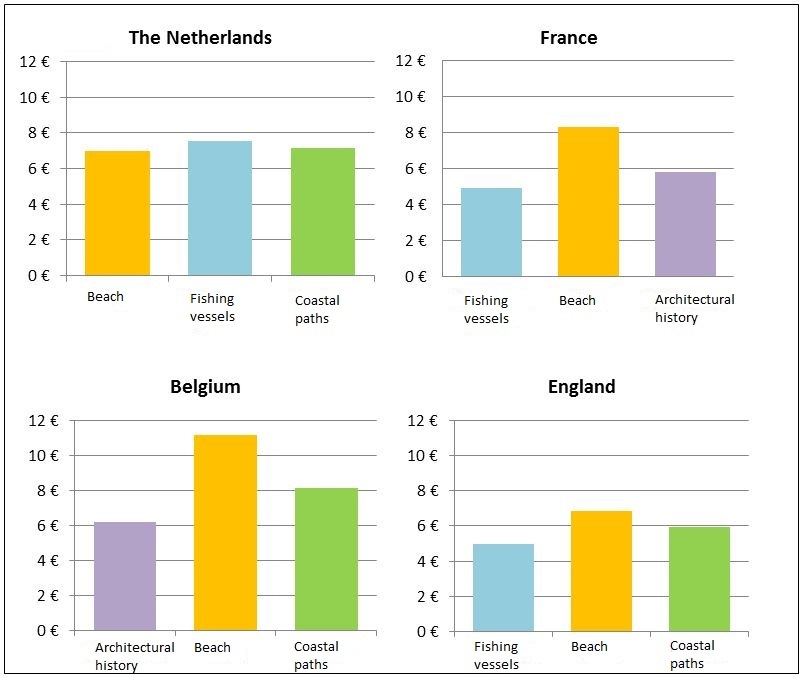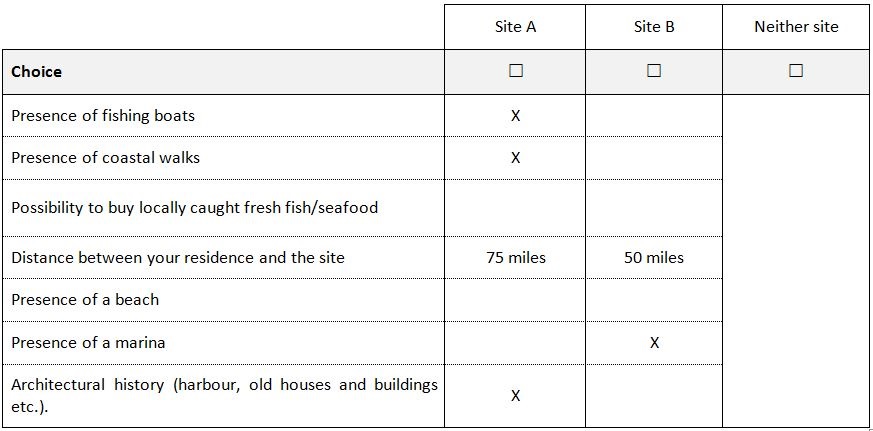Evaluate non market value of fishing activities
Contents
Evaluate non market value of fishing activities
AGROCAMPUS OUEST
Carole Ropars-Collet, Mélody Leplat, Marie Lesueur
Objective
The main function of fishing is to provide basic commodities. However, fishing cannot be reduced to this single function because it jointly produces territorial, social and environmental values. The objective of activity 3.3 is to highlight the demand for the amenities that are produced jointly through commercial fishing. To this end, we aimed to establish which characteristics of coastal sites were valued by visitors, and notably whether the presence of a fishing activity on a coastal site attracts individuals in comparison to a site that lacks such an activity. If this is the case, fishing creates non-market benefits. However, these non-market benefits are difficult to assess as there is no market that directly observes the prices of these amenities. Due to the heterogeneity of the fisheries of the GIFS Project study area, we use stated preference methods to estimate this non- market value (preferable, in this case, to methods of revealed preferences based on observed behaviours). We chose to use choice experiments that directly questions individuals on their preferences between different hypothetical goods described by a set of characteristics. These goods can be locations, products, services, etc. In this study, people interviewed during a face-to-face survey are asked to choose between hypothetical coastal sites. Through the analysis of individual trade-offs between the different site attributes, it is possible to give a value to each of these attributes called Willingness To Pay (WTP).
Methodology
The methodology used is to propose choice alternatives for fictional coastal places to visit to the individuals interviewed during a survey. These choice alternatives are developed by combining different characteristics of a coastal site. These characteristics must be representative of the coastal sites of the entire study area in order to be meaningful to the respondents whether or no French, English, Belgian or Dutch, they know the coast or not, they have a link with fishing sector or not. In order to evaluate the amenities related to the presence of fishing activities, it is necessary to include among the relevant characteristics describing a coastal site some visible attributes, directly linked to a fishing activity. The presence of fishing boats and the ability to buy fishing products directly to local fishermen are these attributes of interest. Besides both attributes, other more classical attributes of coastal sites were chosen: coastal walks, beach, marina and historical architectural heritage (ramparts, a submarine base, old houses and buildings, etc.). These six attributes are qualitative and all have two levels (presence/absence). In order to calculate the willingness to pay to benefit from these attributes, a monetary attribute is required. Visitors in the area are not used to pay to visit coastal sites because the access to recreational natural areas is mostly free. We chose to use the distance to travel by car to a coastal site as a proxy of the cost. 4 levels were chosen, each separated by 25 miles (25 miles, 50 miles, 75 miles, 100 miles). These 7 attributes and their levels are combined to define the alternatives of the choice sets proposed to the respondents. For each choice set, respondents may choose to visit coastal site A or coastal site B; each of these fictitious locations was defined by different levels of attributes. In addition, a third alternative was introduced: the ability to not visit any of the proposed sites, A fractional factorial design was used to build the choice sets proposed to people interviewed. Indeed a full factorial design would have led to propose too many sets of successive choices to an individual (6 attributes with two options and one attribute with four options imply 256 choice sets). In order to optimise the parameter estimates of random utility models, while limiting the number of choices proposed to individuals, an efficient design is used. The final efficient design contains 32 choice situations and excludes dominant alternatives. Finally, these 32 choice situations were broken up into 4 blocks, leading to 4 versions of the questionnaire. Then, each individual faced to 8 choice sets. The table below shows a choice set presented to a respondent.
Example of a choice set presented to an individual
The survey
The survey was conducted in the departments bordering the English Channel and the North Sea, in France, Belgium, the Netherlands and the United Kingdom. These face-to-face interviews were conducted in cities of different sizes, both on the coast and inland. A sampling plan by age and gender was built in order to have a representative sample of the population of each country. Objectives in terms of the number of usable questionnaires were reached in France and the Netherlands. In Belgium, almost double the questionnaires were collected while in England only 80 % of the target was achieved. The sampling plan was well respected in France and England, which means 75 % of the total sample; less in the Netherlands with an overrepresentation of 30-39 year-olds, and in Belgium with a large overrepresentation of 20-29 year-olds. In the Netherlands, interviews were mainly conducted in a major port of Zeeland, contrary to the principle of heterogeneity of surveyed areas. In the end, about 2 000 complete and usable questionnaires were collected.
The choice determinants of the visits
Among the attributes describing the recreational sites, two are produced by the fishing activity (presence of fishing boats, direct sales of products from local fishing). The study of individual choices, using econometric models, allows to show how these attributes of interest are valued by respondents. If the estimated parameter of an attribute is positive, then the presence of this attribute increases the probability of visiting a site with this characteristic: then the attribute is attractive. Introducing interactions between attributes and individual characteristics allows to show some explained individual heterogeneity in both models. However, the random parameters model is more flexible because it introduces also random taste variation between individuals. From our econometric results, the 7 attributes chosen to describe a coastal site are relevant to explain individual choices of visiting coastal sites in each country. All of the characteristics used to describe the sites positively contribute to the utility of the individuals surveyed, except the distance attribute. Indeed, the greater the distance to get to a coastal site is, the less satisfied respondents are. Each site attribute contributes differently to individual utility. Thus, individuals attach greater importance to the presence of a beach, and much less to that of a marina or direct sales.
Willingness to pay for each attribute of a coastal site
From the estimation of the parameters of these models, willingness to pay (WTP) were calculated for site characteristics and for each country of the survey area. The WTP of an attribute is interpreted as the implicit price per individual in order to enjoy the presence of this attribute on a coastal site. Figure 1 below shows the highest three average willingness to pay per country.

- Figure 1: the highest three average willingness to pay per country
What should be remembered is that all WTP are positive. Each qualitative attribute of the survey therefore contributes to the satisfaction of the respondent, but the preferred attribute for the individuals surveyed is the beach; except for the population surveyed in the Netherlands, unrepresentative, however, of the total population of the Netherlands. For individuals in the other countries surveyed, the presence of fishing boats is the third best valued attribute, with a WTP equivalent to that of the architectural heritage in France and to that of the presence of coastal footpaths in the United Kingdom. The WTP for direct sales is relatively higher in France than in other countries. Surveyed individuals therefore like to see fishing boats when walking along the coast, and also to witness direct sales (regardless of purchasing). In France, freshly landed fish by local fishermen and sold directly to consumers on the port or on stalls in small markets is an attraction for visitors. However, WTP for these two attributes of interest is decreasing when interviewed individuals have no link with the fishing sector, but remain positive; especially in Belgium and the Netherlands, but that does not make a difference for respondents from the United Kingdom. Both these characteristics of coastal sites are positive externalities that are produced by inshore fishing.
